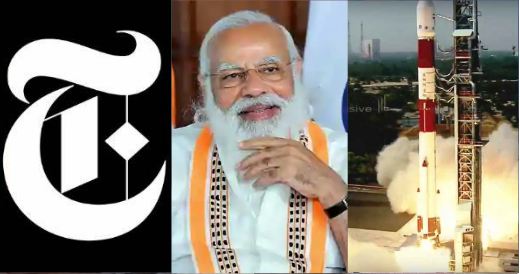On Sunday, the Indian Space Research Organisation (ISRO) launched the ever-so-reliant Polar Satellite Launch Vehicle (PSLV) C51 mission from Satish Dhawan Space Centre in Sriharikota carrying 19 payloads including Brazil’s 637-kg Amazonia-1 (its primary passenger) plus 18 co-passenger satellites. One of these satellites also carried an e-copy of the Bhagavad Gita, saved on an SD-card, as well as a picture of Prime Minister Narendra Modi engraved on its panel.
By successfully launching its first mission of the year, ISRO proved that its workhorse PSLV is one of the most efficient satellite carriers currently operating across the globe. The ISRO mission was built around sending Brazil’s 637-kg Amazonia-1 satellite into space, which is the first Brazilian satellite to be launched from India and is the first dedicated commercial mission of New Space India Limited (NSIL).
Prime Minister Narendra Modi took to Twitter to congratulate Brazil PM Jair Bolsonaro on the successful launch of the Brazilian satellite in both English and Portuguese.
PM Modi tweeted, “Congratulations President @jairbolsonaro on the successful launch of Brazil’s Amazonia-1 satellite by PSLV-C51. This is a historic moment in our space cooperation and my felicitations to the scientists of Brazil. @isro”
Congratulations President @jairbolsonaro on the successful launch of Brazil's Amazonia-1 satellite by PSLV-C51. This is a historic moment in our space cooperation and my felicitations to the scientists of Brazil. @isro
— Narendra Modi (@narendramodi) February 28, 2021
By sending an ally country’s satellite in space, India has shown that its space program has indeed come a long way. The West and especially publications like the New York Times, which mocked and ridiculed the baby steps India took in the daunting field, back in the day, despite not being in the best economic shape must be having a hard time accepting the reality of the incredible feat.
From successfully sending an orbiter to Mars in the very first attempt that no country managed to do ever to developing the Anti-satellite missile to daring to launch a rover on the dark, Southside of the Moon, ISRO has managed to take the bull by the horns lately.
NASA’s Artemis mission to Moon scheduled in 2024 could not have been possible if Chandrayan-1 had not discovered that Moon had hidden polar caps. Chandrayaan-1’s two payloads had confirmed the presence of water ice in cold and shadowed places of Moon.
Read more: New York Times questions India’s ASAT, Indians rip their claim apart
These achievements of ISRO in the last decade barely scratch the surface of what the organisation has achieved in its relatively short history. The ability to punch above its weight is the biggest USP of ISRO and through these missions, it has time and again sealed the lips of its detractors in the West.
